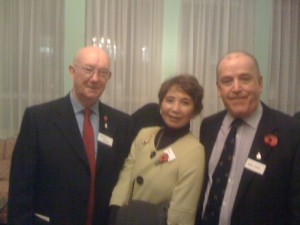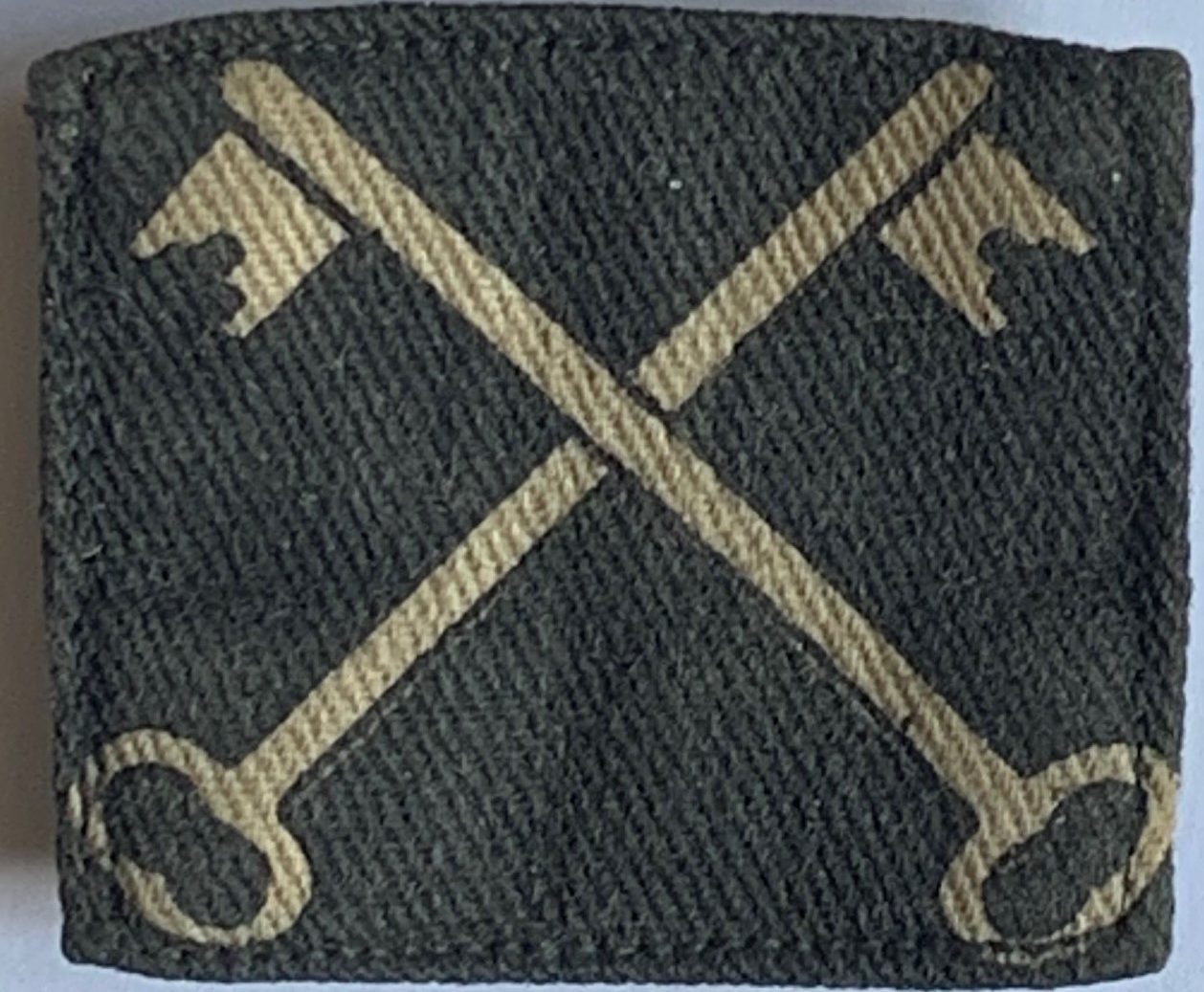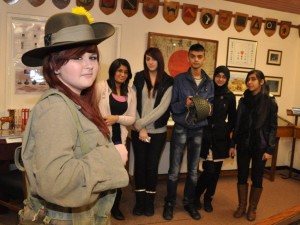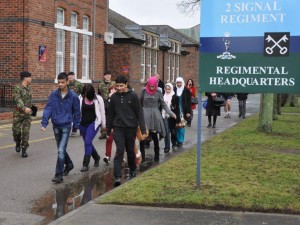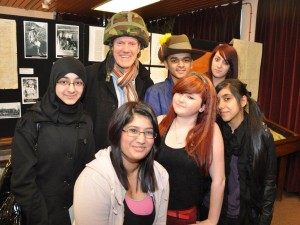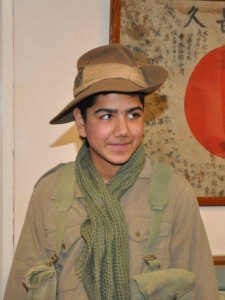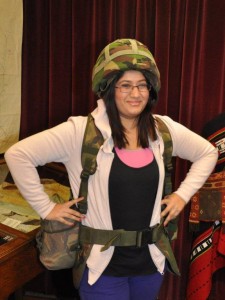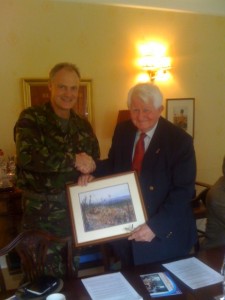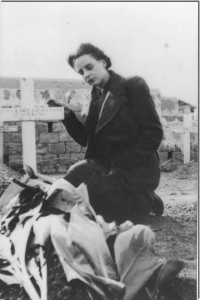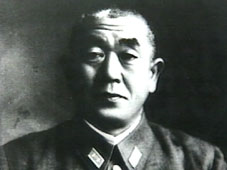Reflections on Kohima
British Gurkhas Pokhara Battlefield Tour to Kohima, 14-22 April 2010
As I write I am looking at a photograph we took of the Kohima battlefield from near the Cameron Memorial on Naga Hill. It is a cloudy April day with grey cumulus threatening rain. In the background is the dark jungle covered peak of Mount Pulebadze. A tall radio mast now stands above the village of Jotsoma where 161st Indian Infantry Brigade formed its defensive box and allowed 24th Indian Mountain Regiment to bring down supportive fire to assist the besieged garrison. As you come down the jungle-clad slopes of Aradura Spur, where Captain Jack Randle won his Victoria Cross, the jungle now gives way to Officers’ quarters and the rust-red roof of the Catholic Church. In the photograph Kohima Ridge forms a gentle parabola from Naga Hill to Aradura Spur but the ridge is now covered with an ugly rash of buildings. There are still some pink, green and yellow splashes of simple Naga homes made of wood and corrugated tin and occasionally, in Naga Village, you come across an Angami house with its traditional crossed roof beams. In the heart of the photograph is a green oasis of trees on Garrison Hill that is the Commonwealth War Cemetery. The azaleas were all in flower in riotous pink when we visited and the roses lovingly tended in their Regimental plots. It is difficult to imagine that just over a half century ago two fading empires collided along their peripheries on these hills and that so many of their sons lie there still.

The study of former battles and campaigns can provide insights and tactical lessons relevant to today’s campaigns. The Battle of Imphal in 1944 was an excellent example of this tenet. General Slim (later Field Marshal, 1st Viscount Slim) remembered the advice he had been given by a Chinese General on how to defeat the Japanese. He was told that the Japanese always planned operations on the slimmest of logistic margins. If they could be held long enough they would over-reach themselves, run out of supplies, and could be defeated. Slim recalled this advice when he drew up 14th Army’s plan of battle for Imphal.
What Slim had not counted on was 31st Japanese Division crossing the Somra hills, in a march as epic as Hannibal’s across the Alps, to besiege the Garrison in Kohima and cut the vital road and supply line to Imphal. The battles of Kohima-Imphal, which were contemporaneous, are excellent examples of planned and reactive battles.
Kohima is a not an easy battle to study. It involved the best parts of 3 Divisions: 31st Japanese Division, 2nd British Division and Brigades from 5th and 7th Indian Divisions. The fighting went on for 64 days over incredibly difficult terrain and involved many Regiments fighting different actions simultaneously. In order to effectively study this complex battle we used the Functions in Combat, the British Army’s principles of war in the military decision making process, as a framework. Our reflections are summarised below.
Command and Control
At the highest level the Battle of Kohima-Imphal was fought between Generals Slim and Mutaguchi. It can be said that Slim nearly lost the battle of Kohima by failing to realise that a Division could move across the Somra Hills to Kohima. However, Mutaguchi and Sato definitely lost the battle, largely due to their inflexible style of command. Lieutenant General Sato did not utilise auftragstaktik or mission command to achieve his commander’s intent.
If Lieutenant General Sato had masked Kohima and pushed on to attack Dimapur the Japanese would have captured the vital supplies they needed and denied them to 4th Corps in Imphal. However, he had been told to capture and hold Kohima and this is precisely what he tried to do, failing to exploit the opportunity to achieve his commander’s intent by taking Dimapur instead.
Once Slim realised that his plan was in danger he rapidly corrected it by moving 161st Indian Infantry Brigade to Dimapur by air and 2nd British Division to Dimapur by rail whilst flying elements of 5th and 7th Indian Divisions to reinforce Imphal.
Slim was also a master at improving morale. If soldiers on the front line were on half rations he made sure that staff officers in rear headquarters were also on half rations. This usually meant that problems were rapidly resolved.
Information and Intelligence
14th Army had very good intelligence. At the start of the battle V Force agents, patrols, scouts and local tribes all provided information about the Japanese crossing the River Chindwin and advancing on Kohima-Imphal. 14th Army also had a good system of acquiring and exploiting information. Dead Japanese were searched for documents and maps which were rapidly sent back for Intelligence staff to translate and analyse. At the Battle of Sangshak, 50th Indian Parachute Brigade recovered the 15th Army plan of attack from a dead Japanese Officer. Despite being surrounded by Japanese forces they realised the value of this information and managed to smuggle it out. Slim was able to exploit this intelligence and it allowed him to readjust his plan of battle by reinforcing Kohima and Imphal.
Firepower
Kohima would almost certainly have fallen if it had not been for the indirect firepower provided by 24th Indian Mountain Regiment based inside 161st Indian Infantry Brigade’s defensive box at Jotsoma, 2 miles across the valley from Kohima. Time and again, Japanese attacks on Kohima Garrison were broken up in the FUP by rapid and accurate artillery support.
Although the Allies had tanks it was very difficult to use them in the mountainous terrain of Nagaland. Often roads had to be specially built to bring them into action. Where they could be used they were a decisive factor, especially at the battle of the tennis court on Garrison Hill, where a Lee-Grant tank was finally manoeuvred into a position to blast the Japanese out of their bunkers.
Protection
Troops that were dug in, especially in deep bunkers with overhead protection, were relatively safe from the effects of indirect fire. This is why it took so long for 2nd British Division to retake Kohima Ridge from the Japanese. As soon as the indirect fire lifted, the Japanese would pop out of their bunkers and start firing at attacking troops.
Tanks were very useful in attacking bunkers because they offered protection against small arms and indirect fire. Tanks often played a crucial part in many attacks at Kohima despite the limitations of their mobility.
Mobility
Slim did not believe that a Division could move across the mountainous jungle from the Chindwin to Kohima. He was wrong. 31st Division managed to move its forces along jungle tracks and used mules, porters and elephants to carry their supplies.
In order to defeat 31st Division, the British had to outflank the dug-in Japanese positions by moving on foot through the dense jungle-covered mountains. Navigation was extremely difficult and often units relied on local Nagas to act as their guides.
Finally, victory at Kohima-Imphal was achieved by Slim’s ability to reinforce and resupply Imphal and Dimapur by air. He was able to reinforce and support Kohima Garrison by redeploying units such as 161st Indian Infantry Brigade, moving them from the Arakan to Dimapur by air at short notice. This allowed Kohima Garrison to be held until further reinforcements arrived.
Combat Service Support
Slim had not forgotten the lesson he had learnt from the Chinese General about defeating the Japanese. At Kohima-Imphal he exploited the fact that the Japanese operated with limited scales of supplies. On the Allied side, the supply depot at Dimapur was 2 miles wide and 11 miles long – a lot of combat service support – with a railhead and airfields. Slim deliberately designed a plan of battle that shortened his supply line whilst lengthening that of the Japanese. When the Japanese failed to capture the supply dumps at Imphal and Dimapur they literally starved. During the battle the 14th Army also used aircraft to re-supply and reinforce their troops, something that had not been done before on such a large scale.
Conclusion
Although Functions in Combat are a relatively new concept in British military doctrine they are applicable to a study of Kohima. Although Kohima was a completely different type of operational environment to ongoing British Army operations in Afghanistan lessons can be drawn. The first is the over-arching importance of intelligence to plan and conduct operations. To this can be added the utilisation of indigenous forces to help procure information and the ability to translate, analyse and utilise it. The main difference is that 14th Army’s objectives were very clear: to defeat a brutal, expansionist enemy. The objectives in Afghanistan are far more complex and make the prosecution of the campaign more difficult. As one of General Stanley McChrystal’s staff officers recently commented, victory in Afghanistan “… is not going to look like a win, smell like a win, or taste like a win.”
Major R G J Beven RGR and Captain D J McKerr QGE June 2010
